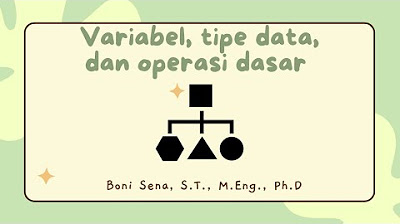O que é uma variável? Venha conhecer o mundo da programação!!!
Summary
TLDRIn this video, Paulo Gabriel introduces the concept of variables and data types in programming, using a relatable analogy of shopping for groceries. He explains that variables represent memory spaces and can store different types of data, like numbers, letters, and logical values. The video covers the importance of understanding data types—such as integers, real numbers, Booleans, and characters—and their memory usage. Additionally, it provides essential rules for naming variables and highlights the importance of avoiding reserved words. This serves as a beginner-friendly guide to understanding foundational programming concepts.
Takeaways
- 😀 Variables store data in the computer's memory, allowing for efficient data processing.
- 😀 A variable is like an address: it has a name, type, and content, and it can only store one value at a time.
- 😀 The computer works with binary data (0s and 1s), which is stored in memory as bytes and accessed by positions.
- 😀 Each variable has a specific size in memory depending on its data type.
- 😀 Data types include logical (Boolean), numeric (integers and real numbers), and literals (characters or strings).
- 😀 Numeric types are divided into integers (no decimal point) and real numbers (with decimals).
- 😀 Integers take 2 bytes of memory, while real numbers take 4 bytes.
- 😀 Logical (Boolean) values only take 1 byte of memory and can only be true or false.
- 😀 Literals, or characters, take 1 byte of memory per character, whether a single letter or a string.
- 😀 Variable names must follow certain rules, such as only using letters, numbers, and underscores, with no spaces or reserved words.
- 😀 The first character of a variable name must be a letter or an underscore, and special characters are restricted.
Q & A
What is a variable in programming?
-A variable represents a space in memory where data can be stored and accessed by a program. It has characteristics such as a name, a type, and content that can change over time.
Why do we need variables in programming?
-Variables are used to store data that a program needs to process. Just like remembering a shopping list, variables help store data that can be accessed and modified during the program’s execution.
How does a computer store data in memory?
-A computer stores data using the binary system, where data is represented as zeros and ones. This data is stored in bytes, which are small units of memory, and each byte can be accessed by its address.
What is the analogy used to explain how variables work?
-The analogy compares variables to an address in your home. Just as an address identifies a specific location with characteristics like the street name and house number, a variable has a name, type, and content that uniquely identifies it in memory.
Can a variable store multiple values at the same time?
-No, a variable can only store one value at a time. However, its content can change over time depending on its use in the program.
How does the size of a variable relate to its type?
-The size of a variable in memory depends on its type. For example, storing a letter requires 1 byte, while storing an integer might require 4 bytes, and a real number may also require 4 bytes.
What are the main data types of variables?
-The main data types of variables are logical (Boolean), numeric (integers and real numbers), and literals (characters or strings). Each type has different memory requirements.
What are the memory requirements for different types of data?
-Logical data (Boolean) requires 1 byte, integers require 2 bytes, real numbers require 4 bytes, and each character in a literal requires 1 byte.
What are the rules for naming variables?
-Variable names can only contain numbers, letters (uppercase or lowercase), and underscores. The first character must be a letter or an underscore, and no spaces or special characters are allowed. Also, reserved words cannot be used as variable names.
What is the difference between integers and real numbers?
-Integers are whole numbers, either positive or negative, without decimal parts. Real numbers are also positive or negative but include decimal parts.
Outlines

Dieser Bereich ist nur für Premium-Benutzer verfügbar. Bitte führen Sie ein Upgrade durch, um auf diesen Abschnitt zuzugreifen.
Upgrade durchführenMindmap

Dieser Bereich ist nur für Premium-Benutzer verfügbar. Bitte führen Sie ein Upgrade durch, um auf diesen Abschnitt zuzugreifen.
Upgrade durchführenKeywords

Dieser Bereich ist nur für Premium-Benutzer verfügbar. Bitte führen Sie ein Upgrade durch, um auf diesen Abschnitt zuzugreifen.
Upgrade durchführenHighlights

Dieser Bereich ist nur für Premium-Benutzer verfügbar. Bitte führen Sie ein Upgrade durch, um auf diesen Abschnitt zuzugreifen.
Upgrade durchführenTranscripts

Dieser Bereich ist nur für Premium-Benutzer verfügbar. Bitte führen Sie ein Upgrade durch, um auf diesen Abschnitt zuzugreifen.
Upgrade durchführenWeitere ähnliche Videos ansehen

Variabel, tipe data dan operasi dasar

C++ 03 | Tipe Data pada Pemrograman C++ | Tutorial Dev C++ Indonesia

Pengenalan Array di Struktur Data

Introduction to C++ | Lecture 1 | C++ and DSA Foundation Course

OOP in Python | Object Oriented Programming | Python for Beginners #lec84

#2 Tipe Data, Variabel, dan Operator
5.0 / 5 (0 votes)
